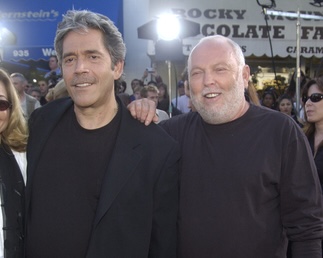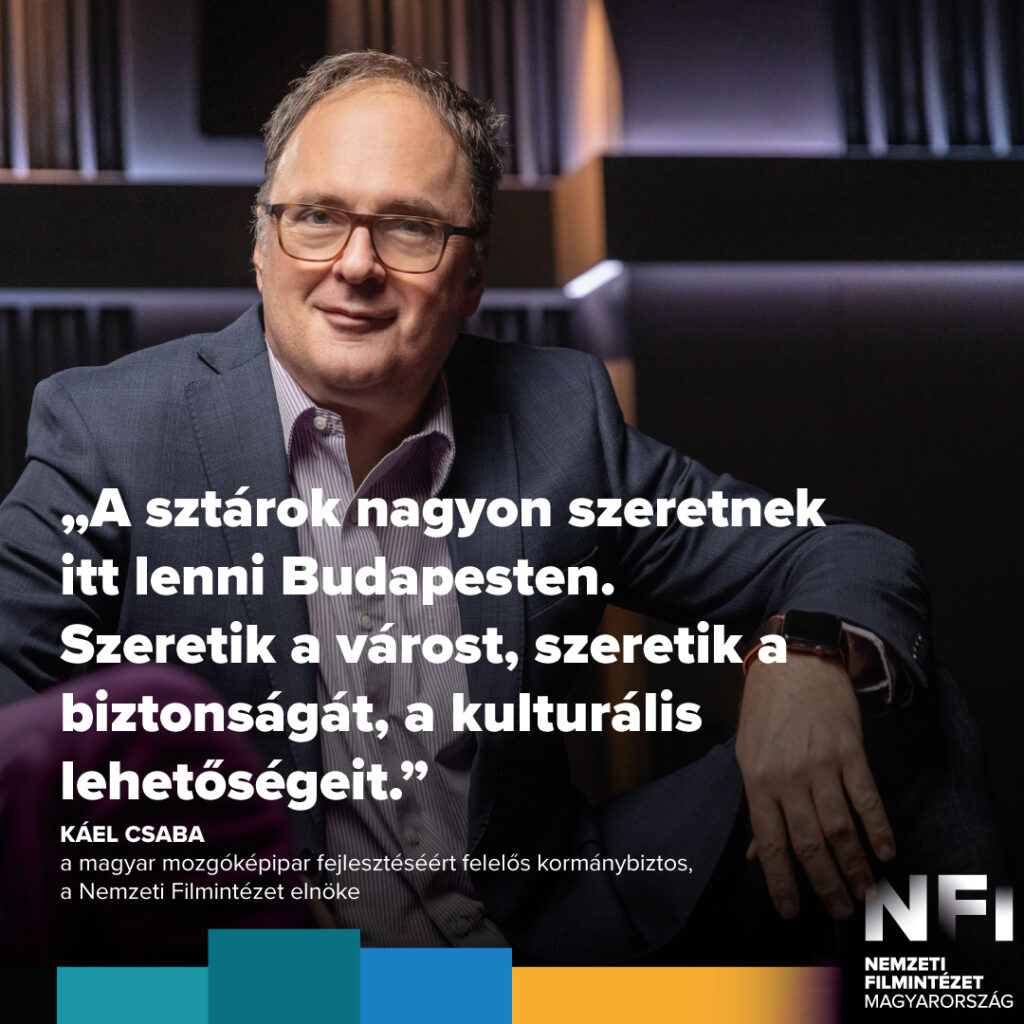While Prime Minister Viktor Orbán is over in Madrid talking up “making Europe great again,” the Hungarian film industry has always been superb. It would take multiple articles to cover Hungary’s own movie history, its influence on Hollywood, famous Hungarians in Hollywood (both in front of and behind the camera), and the present-day demand for Hungarian production talent, not to mention the historic cityscape and cutting-edge studios in Budapest.
A nice place to start is a piece in Hungarian media, an interview of President of the National Film Institute Csaba Káel by Mandiner’s Anita Wolf. Kaél is also the government commissioner responsible for the development of Hungary’s motion picture industry, with domestic film production having closed a record year in 2024.
We include a selection of his responses to questions here below.
State support for making movies
The support system in Hungary has long been such that productions made in our country, both domestic and foreign, can claim 30 percent of their production costs back as indirect state support in the form of a tax refund. The majority take advantage of this opportunity, but a tiny minority do not; strictly speaking, only the latter belong to the independent category.

It is time to acknowledge that the state support for the sector, no matter how much its amount has increased in the last decade, is not enough. It has never been enough, and it never will be. Anyone whose application is rejected by the film institute’s selection committee during the multi-round selection process is obviously looking for reasons, and the easiest place to find them is in politics.
It should also be recognized by now that the period of socialism, when Hungarian filmmakers were used to the state supporting pretty much everyone, is over. After the change of regime, the direction of private film support slowly started, and new state film support organizations were established, from the Hungarian Motion Picture Public Foundation to the Hungarian National Film Fund to the National Film Institute, which was established in 2019.
When producer Andy Vajna (ed. note: Rambo, Total Recall, Die Hard with a Vengeance, Terminator 3, to name just a few) took over the management of the sector as the head of the film fund in 2010, he also highlighted financing as his main goal, and he also started several things whose development was long overdue.
The work and influence of Andy Vajna
Among other things, Vajna realized that the biggest problem of Hungarian films is the quality of the scripts; we still have work to do on this to this day. He therefore emphasized improving quality, and we are his active heirs in this. The difference is that Andy Vajna focused heavily on feature films, while we had to acknowledge that the era had outgrown the privilege of this format.
Streaming channels have taken over the film industry worldwide, with an extremely wide range of genres. We must also adapt to this change by paying the same attention to the entire spectrum instead of focusing on cinema.
There is a good chance, it has happened more than once, that a production intended for the big screen could work much better and be excellently shot as a one-hour TV movie. Similarly, the film institute supports the production of approximately 60 films. A maximum of one-third of these are for cinema, the rest are works intended for television and streaming distribution.
Is cinema slowly dying?
Absolutely not. Viewers are now trickling back in after the coronavirus pandemic, but it certainly needs to redefine itself in order to survive in the long term. It needs to offer films that are enticing enough to make people get up from their comfortable armchairs at home, in front of the TV or laptop.

There are two directions for this. One is to make concentrated commercial-type productions with the greatest possible involvement of private capital. The other important task, if you like, our cultural mission, is to help tell stories based on our own lives, our heroes, our history. If we don’t do it, who will?
Stories of our heroes
A hero can be not only a large-scale historical figure, but also an athlete, a researcher or an ordinary person, or even a character in a literary work.
There is a saying that America has a hero and they make a hundred films about him, and we, I would add, have a hundred and we don’t make a single one of him.
For example, the two immortal lovers Csongor and Tünde, a full-length animated film based on the characters of Attila Dargay from the Vörösmarty work, will be premiered in April. And while we strengthen this line, we cannot forget about our first-time and auteur filmmakers who are just starting out.
There is also hardly any mention of the fact that in previous years, 33 first-time filmmakers were given the opportunity to debut through the National Film Institute, or that this year, Ildikó Enyedi and László Nemes Jeles’ new film, an international co-production with the support of the film institute, will be released to the public
Hunyádi co-production
One of the few positive outcomes of the coronavirus pandemic is that although filming had stopped, our producers managed to conclude some large-scale co-production agreements during the forced break, so we have finally started in this direction.
I think it is really important, I think it is one of the keys to the future. Not only because it makes it easier to find themes, stories, and heroes that connect countries or even an entire region, but because by increasing the budget in this way, the quality of the production will also be different, and of course we can address a much larger audience.
Here is this fantastic film, featuring four directors and one 140 speaking actors, a Hunyadi series made to an outstanding standard, which tells a Hungarian story and elevates a distinctly Hungarian hero – who is also somewhat recognized by other countries, of course – to being a European-level hero.
A Hungarian-Canadian-German-Austrian co-production with Italian, Turkish and Serbian collaborators and a thorough distribution plan for where we will sell it. This is my other passion, by the way: distribution.
Distribution
We want to support Hungarian film productions of the highest quality and also reach as many people as possible worldwide. There is relatively little money from the state budget for international distribution. However, if we can obtain additional resources from private investors or larger distribution partners, i.e., sell our films, we can reinvest the income gained in this way into new productions.
It should be mentioned here that this challenge is not at the Hungarian but at the European level. The EU’s market would be a huge opportunity, which European film production is not taking advantage of at all.
It is true that the infrastructure is not really built up either, as European cinema chains are dying in the shadow of American-based plaza cinemas, which are naturally interested in distributing their own blockbusters.
That’s why we live here, together, in the European Union, and yet we hardly know anything about each other’s film culture, because apart from the smaller art cinemas, there are no French, Polish, German or Italian films on offer anywhere.
At every festival and professional event, I maniacally tell my foreign colleagues that we have to take action and do it together, otherwise even countries that are much richer than us will not be able to finance their film production. It would be enough to adopt the overseas model, which works great.
Common European cinema network
For example, we urgently need to organize a common European cinema network, with European works at the center, of course. Similarly, one or more large common streaming platforms should be created.
As a first step on the path to this, we came up with Filmio four years ago, as a kind of model, where we first made the renovated Hungarian classics available, and then gradually the newer works as well. And for some time now we have been negotiating with the Poles and the Czechs so that we can at least move forward in regional cooperation.
All of this, as I mentioned, is also in our economic interest; we can spend the additional income gained in this way not only on new productions but also for our film training.
Education
The hunger for content in the world regarding motion pictures has long ceased to be concentrated solely on auteur films. There are also numerous industrial applications, from commercials to content running in the virtual world; many, many professionals are involved in their production. But if we only look at classic feature films, the criteria are much stricter there too. A modern screenwriter, cinematographer or director must be universal, able to make a comedy, a crime story or a series episode in the right style and quality, when there is a demand for it.
That is why, for example, in university film education, we encourage students to delve into the professional foundations as much as possible, so that they can later be used in as many fields as possible – geniuses will eventually find their own path as filmmakers.
We are already among the world elite, which is well symbolized by, among many others, the BAFTA and Oscar awards won by our two decorators, Zsuzsanna Sipos, who also works on Dune, and Zsuzsa Mihalek, who won the BAFTA and Oscar awards last year.
On film editor Dávid Jancsó’s Oscar nomination
This is also a great joy. I would like to congratulate him and all Hungarian filmmakers who contributed to the worldwide success of The Brutalist, Dune Part Two and Maria, which were recognized with Oscar nominations.
The collaboration between the state and the private sector in the film industry is exemplary, which has enabled the production of high-quality motion pictures in Hungary in recent years, which stand out at the forefront of world film production. We all deserve recognition for the excellent domestic co-producers of the films, as well as the first-rate professionals of the NFI Filmlabor.
The reputation of their dedicated work was a decisive factor in bringing the production of The Brutalist and Maria, made with a special technique, to Hungary.
It is therefore no coincidence that so many foreign productions are being filmed here, the creators of which, including world stars like Ridley Scott, have consistently praised the technological preparedness, expertise, and professionalism experienced here.
Turning a disadvantage into an advantage
The job of the NFI is to coordinate joint work and protect the interests of almost 20,000 Hungarians working in the sector.
During the coronavirus pandemic, we developed a complex health protection service for international productions so that they would not have to stop at least with preparations. In other words, we turned a disadvantage into an advantage, and as a result, they were the first to return to work after the closures, and foreign crews have been arriving one after another ever since.
Dune was the flagship, and the others quickly followed. We decided that we had to strike while the iron was hot, and we began to vigorously advertise Hungarian studios together with service providers all over the world, but especially in Hollywood; the trade press there now calls us Hollywood on the Danube. In this area, there is a rare harmonious cooperation between the private and public sectors.






